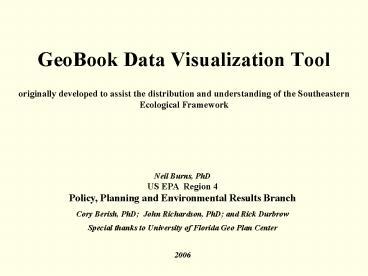GeoBook Data Visualization Tool - PowerPoint PPT Presentation
1 / 18
Title:
GeoBook Data Visualization Tool
Description:
GeoBook Data Visualization Tool. Neil Burns, PhD. US ... Cory Berish, PhD; John Richardson, PhD; and ... a short description of items in the map's legend ... – PowerPoint PPT presentation
Number of Views:104
Avg rating:3.0/5.0
Title: GeoBook Data Visualization Tool
1
GeoBook Data Visualization Tool
originally developed to assist the distribution
and understanding of the Southeastern Ecological
Framework
Neil Burns, PhDUS EPA Region 4Policy, Planning
and Environmental Results Branch Cory Berish,
PhD John Richardson, PhD and Rick Durbrow
Special thanks to University of Florida Geo Plan
Center 2006
2
Southeastern Ecological Framework
Southeastern Ecological Framework
- Covers 8 states
- 90 meter resolution
- Useful at local level
3
- The GeoBook Data Visualization Tool
- What is it?
- Why is it needed?
- What kinds of information does it have?
- How can it help me?
4
Click Here to Open the GeoBook
5
Navigate using the Table of Contents or the
Tabs on the side
6
Navigate using the Table of Contents or the
Tabs on the side
7
Navigate using the Table of Contents or the
Tabs on the side
8
(No Transcript)
9
(No Transcript)
10
Watch a video on the importance of connecting
ecological areas You can substitute another video
into the GeoBook
11
Easily view the SEF and overlay other landscape
layers Text provides a short description of items
in the maps legend
12
Identify agricultural land with poor quality
riparian buffers Text provides a short
description of items in the maps legend
13
Locate urban and transportation
infrastructuresText provides a short description
of items in the maps legend
14
View and query water drainage systems Text
provides a short description of items in the
maps legend
15
Easily view aerial photos and topo maps
16
Contact information and web links can be
customized for users
Click on a feature to get to their web page
17
Toward a National Ecological Framework
Goal Develop a GIS based tool for evaluating
critical ecosystem functions and protecting
connected ecosystem processes across the
continental US.
Provide a baseline ecological framework
assessment that is A. Consistent across the
US B. Temporally repeatable with new NLCD
data C. Extendable/adaptable for multiple
Regional uses D. Linked to programmatic needs
and activities
18
Neil Burns US EPA Region 4 (404) 562-8289































